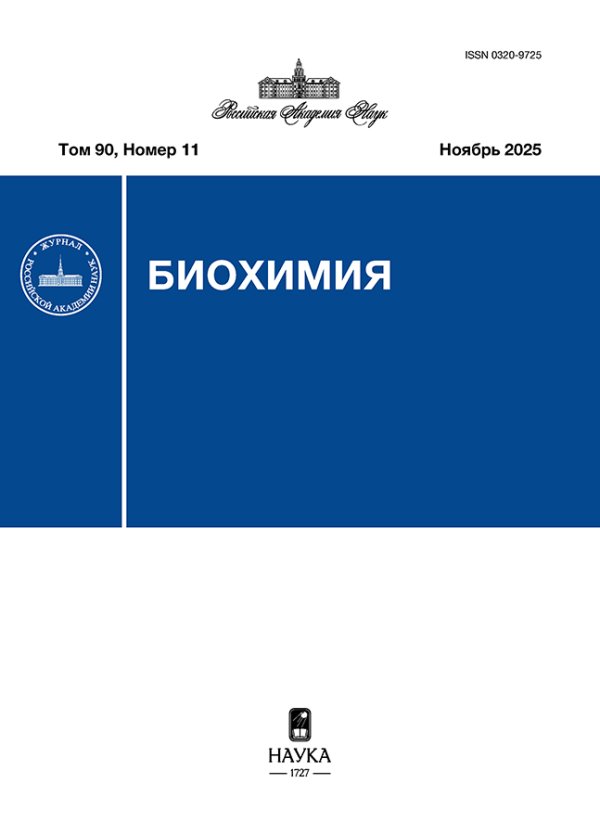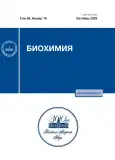Новая двухдоменная лакказа со средним окислительно-восстановительным потенциалом: физико-химические и структурные свойства
- Авторы: Трубицина Л.И1, Трубицин И.В1, Лисов А.В1, Габдулхаков А.Г2, Заварзина А.Г3, Белова О.В1, Ларионова А.П1, Тищенко С.В2, Леонтьевский А.А1
-
Учреждения:
- Федеральный исследовательский центр «Пущинский научный центр биологических исследований РАН», Институт биохимии и физиологии микроорганизмов им. Г.К. Скрябина РАН
- Институт белка РАН
- Московский государственный университет имени М.В. Ломоносова, факультет почвоведения
- Выпуск: Том 88, № 10 (2023)
- Страницы: 2002-2013
- Раздел: Регулярные статьи
- URL: https://journals.rcsi.science/0320-9725/article/view/233522
- DOI: https://doi.org/10.31857/S0320972523100184
- EDN: https://elibrary.ru/OYBJZH
- ID: 233522
Цитировать
Полный текст
Аннотация
Об авторах
Л. И Трубицина
Федеральный исследовательский центр «Пущинский научный центр биологических исследований РАН», Институт биохимии и физиологии микроорганизмов им. Г.К. Скрябина РАН
Email: lyubov_yurevich@mail.ru
142290 Пущино, Московская обл., Россия
И. В Трубицин
Федеральный исследовательский центр «Пущинский научный центр биологических исследований РАН», Институт биохимии и физиологии микроорганизмов им. Г.К. Скрябина РАН142290 Пущино, Московская обл., Россия
А. В Лисов
Федеральный исследовательский центр «Пущинский научный центр биологических исследований РАН», Институт биохимии и физиологии микроорганизмов им. Г.К. Скрябина РАН142290 Пущино, Московская обл., Россия
А. Г Габдулхаков
Институт белка РАН142290 Пущино, Московская обл., Россия
А. Г Заварзина
Московский государственный университет имени М.В. Ломоносова, факультет почвоведения119234 Москва, Россия
О. В Белова
Федеральный исследовательский центр «Пущинский научный центр биологических исследований РАН», Институт биохимии и физиологии микроорганизмов им. Г.К. Скрябина РАН142290 Пущино, Московская обл., Россия
А. П Ларионова
Федеральный исследовательский центр «Пущинский научный центр биологических исследований РАН», Институт биохимии и физиологии микроорганизмов им. Г.К. Скрябина РАН142290 Пущино, Московская обл., Россия
С. В Тищенко
Институт белка РАН142290 Пущино, Московская обл., Россия
А. А Леонтьевский
Федеральный исследовательский центр «Пущинский научный центр биологических исследований РАН», Институт биохимии и физиологии микроорганизмов им. Г.К. Скрябина РАН142290 Пущино, Московская обл., Россия
Список литературы
- Baldrian, P. (2006) Fungal laccases - occurrence and properties, FEMS Microbiol. Rev., 30, 215-242, doi: 10.1111/j.1574-4976.2005.00010.x.
- Janusz, G., Pawlik, A., Świderska-Burek, U., Polak, J., Sulej, J., et al., (2020) Laccase properties, physiological functions, and evolution, Int. J. Mol. Sci., 21, 996, doi: 10.3390/ijms21030966.
- Asada, N., Namba, M., Kodama, T., and Kyogoku, Y. (2004) Circular dichroism of prophenol oxidase in relation to the structural stability in Drosophila melanogaster, Arch. Insect. Biochem. Physiol., 56, 1-6, doi: 10.1002/arch.10137.
- Lisov, A. V., Zavarzina, A. G., Zavarzin, A. A., and Leontievsky, A. A. (2007) Laccases produced by lichens of the order Peltigerales, FEMS Microbiol. Lett., 275, 46-52, doi: 10.1111/j.1574-6968.2007.00858.x.
- Otto, B., Beuchel, C., Liers, C., Reisser, W., Harms, H., and Schlosser, D. (2015) Laccase-like enzyme activities from chlorophycean green algae with potential for bioconversion of phenolic pollutants, FEMS Microbiol. Lett., 362, fnv072, doi: 10.1093/femsle/fnv072.
- Nakamura, K., and Go, N. (2005) Function and molecular evolution of multicopper blue proteins, Cell. Mol. Life Sci., 62, 2050-2066, doi: 10.1007/s00018-004-5076-x.
- Arregui, L., Ayala, M., Gómez-Gil, X., Gutiérrez-Soto, G., Hernández-Luna, C. E., et al. (2019) Laccases: structure, function, and potential application in water bioremediation, Microb. Cell. Fact., 18, 200, doi: 10.1186/s12934-019-1248-0.
- Munk, L., Sitarz, A. K., Kalyani, D. C., Mikkelsen, J. D., and Meyer, A. S. (2015) Can laccases catalyze bond cleavage in lignin? Biotechnol. Adv., 33, 13-24, doi: 10.1016/j.biotechadv.2014.12.008.
- Perna, V., Meyer, A. S., Holck, J., Eltis, L. D., Eijsink, V. G. H., and Agger, J. W. (2020) Laccase-catalyzed oxidation of lignin induces production of H2O2, ACS Sustainable Chem. Eng., 8, 831-841, doi: 10.1021/acssuschemeng.9b04912.
- Zahmatkesh, M., Spanjers, H., Toran, M. J., Blánquez, P., and van Lier, J. B. (2016) Bioremoval of humic acid from water by white rot fungi: exploring the removal mechanisms, AMB Express, 6, 118, doi: 10.1186/s13568-016-0293-x.
- Zavarzina, A. G., Leontievsky, A. A., Golovleva, L. A., and Trofimov, S. Ya. (2004) Biotransformation of soil humic acids by blue laccase of Panus tigrinus 8/18: an in vitro study, Soil Biol. Biochem., 36, 359-369, doi: 10.1016/j.soilbio.2003.10.010.
- Majumdar, S., Lukk, T., Solbiati, J. O., Bauer, S., Nair, S. K., et al. (2014) Roles of small laccases from Streptomyces in lignin degradation, Biochemistry, 53, 4047-4058, doi: 10.1021/bi500285t.
- Trubitsina, L. I., Lisov, A. V., Belova, O. V., Trubitsin, I. V., Demin, V. V., Konstantinov, A. I., Zavarzina, A. G., and Leontievsky, A. A. (2020) Transformation of low molecular compounds and soil humic acid by two domain laccase of Streptomyces puniceus in the presence of ferulic and caffeic acids, PLoS One, 15, e0239005, doi: 10.1371/journal.pone.0239005.
- Trubitsina, L. I., Tishchenko, S. V., Gabdulkhakov, A. G., Lisov, A. V., Zakharova, M. V., and Leontievsky, A. A. (2015) Structural and functional characterization of two-domain laccase from Streptomyces viridochromogenes, Biochimie, 112, 151-159, doi: 10.1016/j.biochi.2015.03.005.
- Góralczyk-Bińkowska, A., Jasińska, A., Długoński, A., Płociński, P., and Długoński, J. (2020) Laccase activity of the ascomycete fungus Nectriella pironii and innovative strategies for its production on leaf litter of an urban park, PLoS One, 15, e0231453, doi: 10.1371/journal.pone.0231453.
- Sun, Y., Liu, Z. L., Hu, B. Y., Chen, Q. J., Yang, A. Z., et al. (2021) Purification and characterization of a thermo- and pH-stable laccase from the litter-decomposing fungus Gymnopus luxurians and laccase mediator systems for dye decolorization, Front Microbiol., 12, 672620, doi: 10.3389/fmicb.2021.672620.
- Gunne, M., and Urlacher, V. B. (2012) Characterization of the alkaline laccase Ssl1 from Streptomyces sviceus with unusual properties discovered by genome mining, PLoS One, 7, e52360, doi: 10.1371/journal.pone.0052360.
- Feng, H., Zhang, D., Sun, Y., Zhi, Y., Mao, L., et al. (2015) Expression and characterization of a recombinant laccase with alkalistable and thermostable properties from Streptomyces griseorubens JSD-1, Appl. Biochem. Biotechn., 176, 547-562, doi: 10.1007/s12010-015-1594-2.
- Molina-Guijarro, J. M., Perez, J., Muñoz-Dorado, J., Guillen, F., Moya, R., et al. (2009) Detoxification of azo dyes by a novel pH-versatile, salt-resistant laccase from Streptomyces ipomoea, Int. Microbiol., 12, 13-21, doi: 10.2436/20.1501.01.77.
- Trubitsina, L. I., Abdullatypov, A. V., Larionova, A. P., Trubitsin, I. V., Alferov, S. V., Ponamoreva, O. N., and Leontievsky, A. A. (2021) Expression of thermophilic two-domain laccase from Catenuloplanes japonicus in Escherichia coli and its activity against triarylmethane and azo dyes, PeerJ, 9, e11646, doi: 10.7717/peerj.11646.
- Kaneko, S., Cheng, M., Murai, H., Takenaka, S., Murakami, S., et al. (2009) Purification and characterization of an extracellular laccase from Phlebia radiata strain BP-11-2 that decolorizes fungal melanin, Biosci. Biotechnol. Biochem., 73, 939-942, doi: 10.1271/bbb.80740.
- More, S. S., Renuka, P. S., Pruthvi, K., Swetha, M., Malini, S. S., et al. (2011) Isolation, purification, and characterization of fungal laccase from Pleurotus sp., Enzyme Res., 2011, 248735, doi: 10.4061/2011/248735.
- Patel, H., Gupte, S., Gahlout, M., and Gupte, A. (2014) Purification and characterization of an extracellular laccase from solid-state culture of Pleurotus ostreatus HP-1, 3 Biotech, 4, 77-84, doi: 10.1007/s13205-013-0129-1.
- Kolyadenko, I., Scherbakova, A., Kovalev, K., Gabdulkhakov, A., and Tishchenko, S. (2021) Engineering the catalytic properties of two-domain laccase from Streptomyces griseoflavus Ac-993, Int. J. Mol. Sci., 23, 65, doi: 10.3390/ijms23010065.
- Couto, S. R., and Herrera, J. L. T. (2006) Industrial and biotechnological applications of laccases: a review, Biotechn. Adv., 24, 500-513, doi: 10.1016/j.biotechadv.2006.04.003.
- Upadhyay, P., Shrivastava, R., and Agrawal, P. K. (2016) Bioprospecting and biotechnological applications of fungal laccase, 3 Biotech, 6, 15, doi: 10.1007/s13205-015-0316-3.
- Kunamneni, A., Camarero, S., García-Burgos, C., Plou, F. J., Ballesteros, A., et al. (2008) Engineering and applications of fungal laccases for organic synthesis, Microb. Cell Fact, 7, 32, doi: 10.1186/1475-2859-7-32.
- Osma, J. F., Toca-Herrera, J. L., and Rodríguez-Couto, S. (2010) Uses of laccases in the food industry, Enzyme Res., 2010, 1-8, doi: 10.4061/2010/918761.
- Coelho, J. H., Eisele, A. P. P., Valezi, C. F., Mattos, G. J., Schirmann, J. G., et al. (2019) Exploring the exocellular fungal biopolymer botryosphaeran for laccase-biosensor architecture and application to determine dopamine and spironolactone, Talanta, 204, 475-483, doi: 10.1016/j.talanta.2019.06.033.
- Wang, F., Xu, L., Zhao, L., Ding, Z., Ma, H., et al. (2019) Fungal laccase production from lignocellulosic agricultural wastes by solid-state fermentation: a review, Microorganisms, 7, 665, doi: 10.3390/microorganisms7120665.
- Mot, A. C., and Silaghi-Dumitrescu, R. (2012) Laccases: complex architectures for one electron oxidations, Biochemistry (Moscow), 77, 1395-1407, doi: 10.1134/S0006297912120085.
- Gunne, M., Hoppner, A., Hagedoorn, P. L., and Urlacher, V. B. (2014) Structural and redox properties of the small laccase Ssl1 from Streptomyces sviceus, FEBS J., 281, 4307-4318, doi: 10.1111/febs.12755.
- Laemmli, U. K. (1970) Cleavage of structural proteins during the assembly of the head of bacteriophage T4, Nature, 227, 680-685, doi: 10.1038/227680a0.
- Heinfling, A., Martinez, A. T., Martinez, M. J., Bergbauer, M., and Szewzyc, U. (1998) Purification and characterization of peroxidases from the dye-decolorizing fungus Bjerkandera adusta, FEMS Microbiol. Lett., 165, 43-50, doi: 10.1111/j.1574-6968.1998.tb13125.x.
- Wariishi, H., Valli, K., and Gold, M. H. (1992) Manganese(II) oxidation by manganese peroxidase from the basidiomycete Phanerochaete chrysosporium. Kinetic mechanism and role of chelators, J. Biol. Chem., 267, 23688-23695, doi: 10.1016/S0021-9258(18)35893-9.
- Britton, H. T. K., and Robinson, R. A. (1931) Universal buffer solutions and the dissociation constant of veronal, J. Chem. Soc., 10, 1456-1462, doi: 10.1039/jr9310001456.
- Olbrich, A. C., Schild, J. N., and Urlacher, V. B. (2019) Correlation between the T1 copper reduction potential and catalytic activity of a small laccase, J. Inorg. Biochem., 201, 110843, doi: 10.1016/j.jinorgbio.2019.110843.
- Zavarzina, A. G., Kravchenko, E. G., Konstantinov, A. I., Perminova, I. V., Chukov, S. N., and Demin, V. V. (2019) Comparison of the properties of humic acids extracted from soils by alkali in the presence and absence of oxygen, Eur. Soil Sci., 52, 880-891, doi: 10.1134/S1064229319080167.
- McCoy, J., Grosse-Kunstleve, R. W., Adams, P. D., Winn, M. D., Storoni, L. C., et al. (2007) Phaser crystallographic software Airlie, J. Appl. Crystallogr., 40, 658-674, doi: 10.1107/S0021889807021206.
- Afonine, P. V., Grosse-Kunstleve, R. W., Echols, N., Headd, J. J., Moriarty, N. W., et al. (2012) Towards automated crystallographic structure refinement with phenix.refine, Acta Crystallogr. D Biol. Crystallogr., 68, 352-367, doi: 10.1107/S0907444912001308.
- Emsley, P., Lohkamp, B., Scott, W. G., and Cowtan, K. (2010) Features and development of Coot, Acta Crystallogr. D Biol. Crystallogr., 66, 486-501, doi: 10.1107/S0907444910007493.
- Chen, V. B., Wedell, J. R., Wenger, R. K., Ulrich, E. L., Markley, J. L. (2015) MolProbity for the masses-of data, J Biomol. NMR, 63, 77-83, doi: 10.1007/s10858-015-9969-9.
- DeLano, W. L. (2002) The PyMOL Molecular Graphics System, Delano Scientific, San Carlos.
- Lisov, A. V., Trubitsina, L. I., Lisova, Z. A., Trubitsin, I. V., Zavarzina, A. G., and Leontievsky, A. A. (2019) Transformation of humic acids by two-domain laccase from Streptomyces anulatus, Process Biochemistry, 76, 128-135, doi: 10.1016/j.procbio.2018.11.001.
- Durao, P., Chen, Z., Fernandes, A. T., Hildebrandt, P., Murgida, D. H., et al. (2008) Copper incorporation into recombinant CotA laccase from Bacillus subtilis: characterization of fully copper loaded enzymes, J. Biol. Inorg. Chem., 13, 183-193, doi: 10.1007/s00775-007-0312-0.
- Gallaway, J., Wheeldon, I., Rincon, R., Atanassov, P., Banta, S., Calabrese, S., et al. (2008) Oxygen-reducing enzyme cathodes produced from SLAC, a small laccase from Streptomyces coelicolor, Biosens. Bioelectron., 23, 1229-1235, doi: 10.1016/j.bios.2007.11.004.
- Blánquez, A., Rodríguez, J., Brissos, V., Mendes, S., Martins, L. O., et al. (2019) Decolorization and detoxification of textile dyes using a versatile Streptomyces laccase-natural mediator system, Saudi J. Biol. Sci., 26, 913-920, doi: 10.1016/j.sjbs.2018.05.020.
- Xu, F. (1996) Oxidation of phenols, anilines, and benzenethiols by fungal laccases: correlation between activity and redox potentials as well as halide inhibition, Biochemistry, 35, 7608-7614, doi: 10.1021/bi952971a.
- Kumar, V. P., Sridhar, M., and Rao, R. G. (2022) Biological depolymerization of lignin using laccase harvested from the autochthonous fungus Schizophyllum commune employing various production methods and its efficacy in augmenting in vitro digestibility in ruminants, Sci. Rep., 12, 11170, doi: 10.1038/s41598-022-15211-9.
- Agustin, M. B., de Carvalho, D. M., Lahtinen, M. H., Hilden, K., Lundell, T., et al. (2021) Laccase as a tool in building advanced lignin-based materials, ChemSusChem, 14, 4615-4635, doi: 10.1002/cssc.202101169.
Дополнительные файлы










